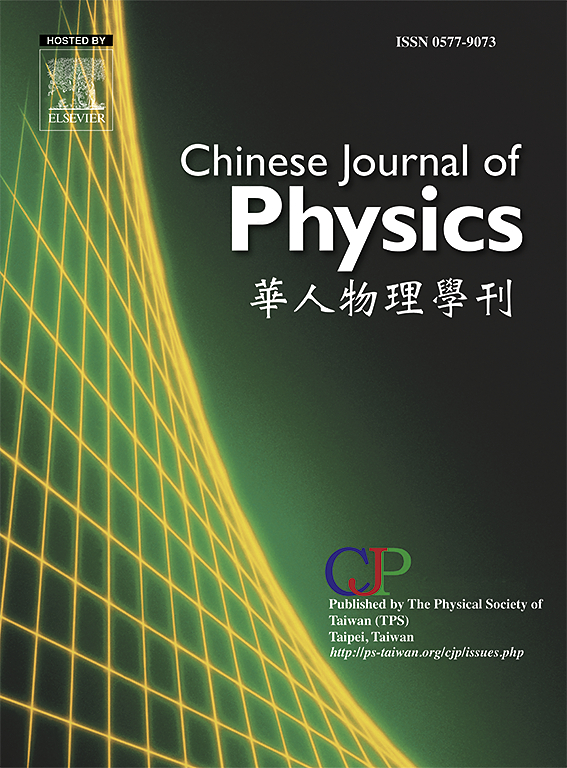Bouncing cosmological models and cosmic acceleration in f(Q,Lm) theory: A path beyond the big bang singularity
IF 4.6
2区 物理与天体物理
Q1 PHYSICS, MULTIDISCIPLINARY
引用次数: 0
Abstract
This manuscript explores bouncing cosmological solutions in the recently developed gravity theory, where represents non-metricity and denotes the matter-Lagrangian density. We analyze a spatially flat, homogeneous and isotropic universe with an isotropic matter distribution, considering a specific functional form of to examine its impact on cosmic evolution. By solving the modified field equations, we investigate different bounce models and assess their viability through a detailed analysis of cosmological parameters. Our findings indicate that the energy density remains positive while pressure turns negative near the bounce, with the null energy condition being violated in all models around the bounce point except oscillatory bounce model. This violation is a critical requirement for realizing a non-singular cosmological transition. The effective state parameter shifts from phantom-like values near the bounce to quintessence-like behavior at late times, depending on the model parameters. In particular, the symmetric bounce model enters a strong phantom regime signaling cosmic acceleration at late times. These results reinforce the physical viability of stable, singularity-free bounce solutions and suggest that gravity could serve as a promising alternative to inflationary cosmology for describing the early universe dynamics.
f(Q,Lm)理论中的弹跳宇宙学模型和宇宙加速度:一条超越大爆炸奇点的路径
本文探讨了最近发展的f(Q,Lm)引力理论中的弹跳宇宙学解,其中Q表示非度规性,Lm表示物质-拉格朗日密度。我们分析了一个具有各向同性物质分布的空间平坦、均匀和各向同性的宇宙,考虑了f(Q,Lm)的特定函数形式,以研究其对宇宙演化的影响。通过求解修正的场方程,我们研究了不同的弹跳模型,并通过对宇宙学参数的详细分析来评估它们的可行性。研究结果表明,弹跳点附近的能量密度为正,而压力为负,弹跳点附近除振荡弹跳模型外,所有模型都不符合零能条件。这种违背是实现非奇异宇宙跃迁的关键条件。根据模型参数的不同,有效状态参数从弹跳附近的幻像值ω>;−1转变为后期的典型行为ω<; ω<−13。特别是,对称弹跳模型在晚些时候进入一个强幻相状态,表明宇宙加速。这些结果加强了稳定、无奇点弹跳解的物理可行性,并表明f(Q,Lm)引力可以作为描述早期宇宙动力学的暴胀宇宙学的一个有希望的替代方案。
本文章由计算机程序翻译,如有差异,请以英文原文为准。
求助全文
约1分钟内获得全文
求助全文
来源期刊

Chinese Journal of Physics
物理-物理:综合
CiteScore
8.50
自引率
10.00%
发文量
361
审稿时长
44 days
期刊介绍:
The Chinese Journal of Physics publishes important advances in various branches in physics, including statistical and biophysical physics, condensed matter physics, atomic/molecular physics, optics, particle physics and nuclear physics.
The editors welcome manuscripts on:
-General Physics: Statistical and Quantum Mechanics, etc.-
Gravitation and Astrophysics-
Elementary Particles and Fields-
Nuclear Physics-
Atomic, Molecular, and Optical Physics-
Quantum Information and Quantum Computation-
Fluid Dynamics, Nonlinear Dynamics, Chaos, and Complex Networks-
Plasma and Beam Physics-
Condensed Matter: Structure, etc.-
Condensed Matter: Electronic Properties, etc.-
Polymer, Soft Matter, Biological, and Interdisciplinary Physics.
CJP publishes regular research papers, feature articles and review papers.
 求助内容:
求助内容: 应助结果提醒方式:
应助结果提醒方式:


